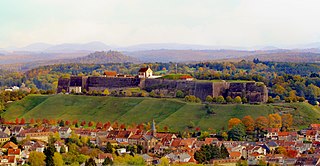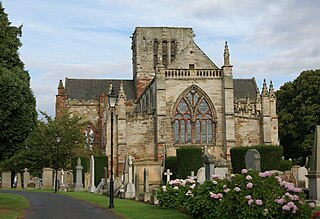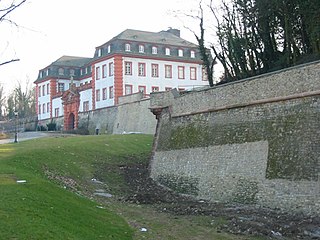Broughty Castle is a historic castle on the banks of the river Tay in Broughty Ferry, Dundee, Scotland. It was completed around 1495, although the site was earlier fortified in 1454 when George Douglas, 4th Earl of Angus received permission to build on the site. His son Archibald Douglas, 5th Earl of Angus was coerced into ceding the castle to the crown. The main tower house forming the centre of the castle with four floors was built by Andrew, 2nd Lord Gray who was granted the castle in 1490.

Givet is a commune in the Ardennes department in northern France very close to the Belgian border. It lies on the river Meuse where Emperor Charles V built the fortress of Charlemont. It borders the French municipalities of Fromelennes to the east and Rancennes to the south and Foisches to the southeast.

Barracks are usually a group of long buildings built to house military personnel or laborers. The English word comes via French from an old Spanish word "barraca" (hut), originally referring to temporary shelters or huts for various people and animals, but today barracks are usually permanent buildings for military accommodation. The word may apply to separate housing blocks or to complete complexes, and the plural form often refers to a single structure and may be singular in construction.

Harfleur is a commune in the Seine-Maritime department in the Normandy region of northern France.

Bitche is a commune in the Moselle department of the Grand Est administrative region in north-eastern France. It is the Pays de Bitche's capital city and the seat of the canton of Bitche and the communauté de communes du Pays de Bitche.

Péronne is a commune of the Somme department in Hauts-de-France in northern France.

The Fortress of Luxembourg refers to the former fortifications of Luxembourg City, the capital of the Grand Duchy of Luxembourg, which were mostly dismantled in 1867. The fortress was of great strategic importance for the control of the Left Bank of the Rhine, the Low Countries, and the border area between France and Germany.

Minerve is a commune in the Hérault department in the Occitanie region in southern France. It is the namesake of the Minervois wine region.

Navarrenx is a commune in the department of Pyrénées-Atlantiques (Béarn) and the region Nouvelle-Aquitaine. The gentilé is Navarre. Since 2014, the town has been in the association Les Plus Beaux Villages de France.

The Siege of Duncannon took place in 1645, during the Irish Confederate Wars. An Irish Catholic Confederate army under Thomas Preston besieged and successfully took the town of Duncannon in County Wexford from an English Parliamentarian garrison. The siege was the first conflict in Ireland in which mortars were utilized.

The Sieges of Haddington were a series of sieges staged at the Royal Burgh of Haddington, East Lothian, Scotland, as part of the War of the Rough Wooing, one of the last Anglo-Scottish Wars. Following Regent Arran's defeat at the battle of Pinkie Cleugh on Saturday 10 September 1547, he took Haddington, with 5000 troops including French mercenaries and troops sent by Henry II of France to bolster the Auld Alliance. Afterwards, Francis Talbot, 5th Earl of Shrewsbury took it with nearly 15,000. The English forces built artillery fortifications and were able to withstand an assault by the besieging French and Scots troops supported by heavy cannon in July 1548. Although the siege was scaled down after this unsuccessful attempt, the English garrison abandoned the town on 19 September 1549, after attrition by Scottish raids at night, sickness, and changing political circumstance.

The Fortress of Mainz was a fortressed garrison town between 1620 and 1918. At the end of the Napoleonic Wars, under the term of the 1815 Peace of Paris, the control of Mainz passed to the German Confederation and became part of a chain of strategic fortresses which protected the Confederation. With the dissolution of the Confederation and the Austro-Prussian War, control of the fortress first passed to Prussia, and, after the 1871 Unification of Germany, to the German Empire.

Fort de Champigny was built following the Franco-Prussian War to defend Paris. Located to the southeast of Paris in Chennevières-sur-Marne, the fort was part of an outer ring of fortifications built in response to improvements in the range and effectiveness of artillery since the construction of the Thiers fortifications of the 1840s. It was built in accordance with improved principles of fortification developed for the Séré de Rivières system.

The recapture of Bahia was a Spanish-Portuguese military expedition in 1625 to retake the city of Salvador da Bahia in Brazil from the forces of the Dutch West India Company (WIC).

The Siege of Leuven was an important siege in the Thirty Years' War in which a Franco-Dutch army under Frederick Henry of Orange and the French Marshals Urbain de Maillé-Brezé and Gaspard III de Coligny, who had invaded the Spanish Netherlands from two sides, laid siege to the city of Leuven, defended by a force of 4,000 comprising local citizen and student militias with Walloons, Germans and Irish of the Army of Flanders under Anthonie Schetz, Baron of Grobbendonck. Poor organization and logistics and the spread of sickness among the French, along with the appearance of a relief army of 11,000 Spanish and Italian troops under Ottavio Piccolomini, forced the invading army to lift the siege. This failure allowed the Spanish forces to take the initiative and soon the invaders were forced into a headlong retreat.

The Lines of Contravallation of Gibraltar, known in English as the "Spanish Lines", were a set of fortifications built by the Spanish across the northern part of the isthmus linking Spain with Gibraltar. They later gave their name to the Spanish town of La Línea de la Concepción. The Lines were constructed after 1730 to establish a defensive barrier across the peninsula, with the aim of preventing any British incursions, and to serve as a base for fresh Spanish attempts to retake Gibraltar. They played an important role in the Great Siege of Gibraltar between 1779 and 1783 when they supported the unsuccessful French and Spanish assault on the British-held fortress. The siege was ended after the lines of contravallation were attacked by British and Dutch forces under the command of the Governor of Gibraltar,General Augustus Eliot. The attack caused the Spanish forces to retreat and abandon the fortifications and the combined British led forces virtually destroyed all the Spanish gun batteries and the enemy cannon and munitions either captured or destroyed. This attack is still commemorated to this day and is known as 'Sortie Day'.

The Capture of Le Quesnoy was an engagement of the First World War that took place on 4 November 1918 as part of the Battle of the Sambre. Elements of the New Zealand Division scaled the fortified walls of the French town of Le Quesnoy and captured it from elements of the defending German 22nd Division.

The Battle of Borgerhout was a battle during the Eighty Years' War, of the Spanish Army of Flanders led by Alexander Farnese, Prince of Parma, upon a fortified camp at the village of Borgerhout, near Antwerp, where several thousand French, English, Scottish, and Walloon soldiers in service of the recently created Union of Utrecht were stationed. It took place during the reconquest by the armies of Philip II of Spain of the Burgundian Netherlands, whose different provinces had united in 1576 under the Pacification of Ghent to drive out the foreign troops and to grant religious liberty to Protestants.

The Capture of Geertruidenberg was a military event that took place on August 28, 1573 during the Eighty Years' War and the Anglo–Spanish War. The capture was conducted by an English, French Huguenot, and Fleming force led by Colonel de Poyet. A small assault force led by Walter Morgan captured the main gate which enabled the complete surprise of the garrison, most of whom were put to the sword.

Parc Sergent Blandan, also shortened to Parc Blandan, is an urban park in the 7th arrondissement of Lyon in Lyon, France adjacent to Cimetière de la Guillotière Ancien. With an area of 17 hectares, the park opened to the public on 13 September 2013 at the location of Caserne sergent Blandan, a military barracks previously known as "Fort Lamothe".

![]()


















